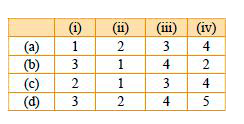Complete Solutions to EVALUATION (MCQs) of chapter PHYSICAL AND CHEMICAL EQUILIBRIUM of Class 11 book with complete answers and questions
| Class 11 | CHEMISTRY |
| Chapter | PHYSICAL AND CHEMICAL EQUILIBRIUM |
| TAMILNADU GOVT | EVALUATION (MCQs) |
| Number Of Questions | 25 |
| Academic Year | 2023-24 |
If `K_b` and `K_f` for a reversible reactions are `0.8 xx 10^(-5)` and `1.6 xx 10^(-4)` respectively, the value of the equilibrium constant is,
View SolutionAt a given temperature and pressure, the equilibrium constant values for the equilibria
`3A_(2)+B_(2)+2C overset(K_1) harr 2A_(3)BC` and
`A_(3)+BC overset(K_2) harr (3)/(2) [A_2]+(1)/(2)B_(2)C`
The relation between `K_(1) " and " K_(2)` is
View SolutionThe equilibrium constant for a reaction at room temperature is K1 and that at 700 K is K2. If `K1 gt K2`, then
View SolutionThe formation of ammonia from `N_(2)(g) " and " H_(2)(g)` is a reversible reaction
`N_(2)(g)+3H_(2)(g) harr 2NH_(3)(g)+" Heat "`
What is the effect of increase of temperature on this equilibrium reaction
View SolutionSolubility of carbon dioxide gas in cold water can increased by
View SolutionWhich one of the following in incorrect statement ?
View Solution`K_(1) " and " K_(2)` are the equilibrium constants for the reactions respectively.
`{:(N_(2)(g)+O_(2)(g) overset(k_1) harr 2NO(g)),(2NO(g)+O_(2)(g) overset(K_2) harr 2NO_(2)(g)):}`
What is the equilibrium constant for the reaction `NO_(2)(g) harr (1)/(2)N_(2)(g)+O_(2)(g)`
View SolutionIn the equilibrium, `2A(g) harr 2B(g)+ C_(2)(g)`
the equilibrium concentrations of A, B and `C_2` at 400 K are `1 xx 10^(-4) M, 2.0 xx 10^(-3) M, 1.5 xx 10^(-4) M` respectively. The value of `K_C` for the equilibrium at 400 K is
View SolutionAn equilibrium constant of `3.2 xx 10^(-6)` for a reaction means, the equilibrium is
View Solution`(K_C)/(K_P)` for the reaction, `N_(2)(g) +3H_(2)(g) harr 2NH_(3)(g)` is
View SolutionFor the raction `AB(g) harr A(g)+B(g)`, at equilibrium, AB is 20% dissociated at a total pressure of P, The equilibrium constant `K_p` is related to the total pressure by the expression
View SolutionIn which of the following equilibrium, `K_(p) " and " K_(c)` are not equal?
View SolutionIf x is the fraction of `PCl_(5)` dissociated at equilibrium in the reaction
`PCl_(5) harr PCl_(3) + Cl_(2)`
then starting with `0.5` mole of `PCl_(5)`, the total number of moles of reactants and products at equilibrium in
View SolutionThe values of `K_(P_1) " and " K_(P_2)` for the reactions
`X harr Y + Z`
`A harr 2B` are in the ratio `9 : 1` if degree of dissociation and initial concentration of X and A be equal then total pressure at equilibrium `P_(1) " and " P_(2)` are in the ratio
View SolutionIn the reaction,
` Fe (OH)_(3) (s) harr Fe^(3+) (aq) + 3OH^(-)(aq)`,
if the concentration of `OH^(-)` ions is decreased by 1/4 times, then the equilibrium concentration of `Fe^(3+)` will
View SolutionConsider the reaction where `K_(P) = 0.5` at a particular temperature
`PCl_(5) (g) harr PCl_(3) (g) + Cl_(2) (g)`
if the three gases are mixed in a container so that the partial pressure of each gas is initially I atm, then which one of the following is true
View SolutionEquimolar concentrations of `H_(2) " and " I_(2)` are heated to equilibrium in a 1 litre flask. What percentage of initial concentration of `H_(2)` has reacted at equilibrium if rate constant for both horward and reverse reactions are equal
View SolutionIn a chemical equilibrium, the rate constant for the forward reaction is `2.5 xx 10^(2)` and the equilibrium constant is 50. The rate constant for the reverse reaction is,
View SolutionWhich of the following is not a general characteristic of equilibrium involving physical process
View SolutionFor the formation of Two moles of `SO_(3) (g) " from " SO_(2) " and " O_(2)`, the equilibrium constant is `K_(1)`. The equilibrium constant for the dissociation of one mole of `SO_(3) " into " SO_(2) " and " O_(2)` is
View SolutionMatch the equilibria with the corresponding conditions,
i) Liquid `harr` Vapour
ii) Solid ` harr` Liquid
iii) Solid `harr` Vapour
iv) solute (s) `harr` Solute (Solution)
1) melting point
2) Saturated solution
3) Boiling point
4) Sublimation point
5) Unsaturated solution

View SolutionConsider the following reversible reaction at equilibrium,` A + B harr C,` If the concentration of the reactants A and B are doubled, then the equilibrium constant will
View Solution`[Co (H_(2)O)_(6)]^(2+) (aq) ("pink") + 4Cl^(-) (aq) harr [CoCl_(4)]^(2-) (aq) ("blue") + 6 H_(2) O (l)`
In the above reaction at equilibrium, the reaction mixture is blue in colour at room temperature. On cooling this mixture, it becomes pink in colour. On the basis of this information, which one of hte following is true?
View SolutionThe equilibrium constants of the following reactions are :
`N_(2) + 3H_(2) harr 2NH_(3)" , "K_(1)`
`N_(2) + O_(2) harr 2NO" , "K_(2)`
`H + (1)/(2)O_(2) harr H_(2) O" , "K_(3)`
The equilibrium constant (K) for the reaction ,
`2NH_(3) + (5)/(2) O_(2) overset (k) (harr) 2NO + 3H_(2)O`, will be
View SolutionA 20 litre container at 400 K contains `CO_(2)(g)` at pressure `0.4` atm and an excess of SrO (neglect the volume of solid SrO). The volume of the container is now decreased by moving the movable piston fitted in the container. The maximum volume of the container, when pressure of `CO_2` attains its maximum value will be :
Given that : `SrCO_(2)(S) harr SrO(S)+ CO_(2)(g)`
`K_(p)= 1.6` atm
View Solution
EVALUATION (MCQs) questions and complete solutions for chapter PHYSICAL AND CHEMICAL EQUILIBRIUM of FULL MARKS CHEMISTRY(TAMIL) of Class 11